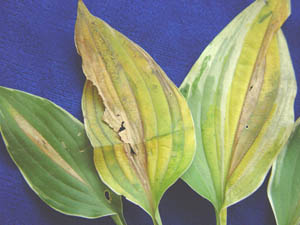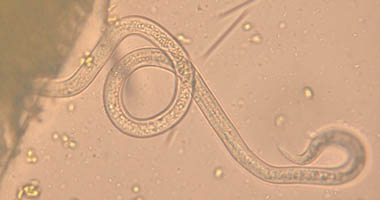What Are Foliar Nematodes? | |
|---|---|
| August 7, 2008 | |
|
Many people think nematodes are pathogens that live exclusively in the soil, causing root problems to plants. We also have some nematodes that cause problems to above-ground plant parts in Illinois. Pinewood nematode is a very common example. The foliar nematode of hosta is not as common but also occurs in Illinois. Foliar nematodes can overwinter here and may infest many herbaceous hosts, including hostas, ferns, chrysanthemums—, begonias, anemone, creeping phlox, ground ivy, windflower, and heuchera. Nematodes are microscopic, unsegmented worms that live in plant stems, leaves, and roots. If you can see worms in or on your plants, they are not nematodes. Nematodes are microscopic. They feed on plant material, stunting or killing plants. Pinewood nematodes kill entire, mature pines. Foliar nematodes include several species from the genus Aphelenchoides that commonly feed inside leaves. Plant infection occurs when the nematodes migrate from the soil surface up to the plant stems and onto leaf surfaces in a film of moisture. They enter leaves via stomates and begin feeding on parenchyma cells. The leaves eventually die and fall to the soil surface, where they are the source of reinfestation. Obviously, foliar nematodes spread easily in wet weather or on irrigated plants. Look for dead leaf material that is limited by veins. Because they have a parallel vein pattern, infected hostas exhibit stripes of necrotic tissue, as in the image.  Chrysanthemums have blocky dead areas because that plant has a net vein pattern. Similar symptoms can also be caused by bacterial pathogens. In the lab, the two are easy to distinguish. Sectioned tissue from bacterial lesions exude bacteria in a stream when viewed with a dissecting microscope or a good hand lens. If foliar nematodes are present, they can be seen with a microscope as well. Typically, we cut pieces of necrotic tissue, soak them in a dish for a short time; and the nematodes swim out of the leaf and into the water. The image shows foliar nematodes emerging from the cut edge of a hosta leaf, viewed with a compound microscope.  Foliar nematodes may reduce plant vitality and aesthetics. In some cases, plants are killed. In addition, plants under nematode stress are more susceptible to damage from other diseases and unfavorable weather conditions. Nematodes are disseminated by water. This includes rain, dew, overhead sprinklers, and wet tools and animals. It is always best to work with plants when they are dry. Nematodes can also survive in a dormant state for up to a year in leaf debris in warm climates. The best pest management practices we can recommend are these:
| |
| Author: | Nancy Pataky |
